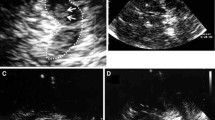Abstract
The aim of this study is to assess the presence of substantia nigra (SN) hypoechogenicity in a cohort of Friedreich’s ataxia (FRDA) patients and its possible association with restless syndrome (RLS). Fourteen genetically confirmed FRDA patients and 14 sex- and age-matched healthy controls underwent transcranial sonography examination to evaluate the area of echogenicity of the SN. Both groups were clinically assessed with the essential and additional diagnostic criteria for RLS established by the International RLS Study Group. Ataxia was evaluated using the Scale for the Assessment and Rating of Ataxia. We did not find significant differences between the mean sum area of SN echogenicity in FRDA patients and in controls. Only one patient in the FDRA group and two control subjects showed SN hypoechogenicity. Two out of the 14 FDRA patients and one of the controls fulfilled diagnostic criteria for RLS. The areas of SN echogenicity in the two FRDA patients with RLS were the lowest found in this group. We conclude that our data do not support the notion that SN hypoechogenicity is related to FRDA itself, although it might be associated with RLS.
Similar content being viewed by others
Abbreviations
- CDN:
-
cerebellar dentate nucleus
- FRDA:
-
Friedreich’s ataxia
- FRN:
-
frataxin gene
- RLSS:
-
restless legs syndrome
- SARA:
-
Scale for the Assessment and Rating of Ataxia
- SN:
-
substantia nigra
- TCS:
-
transcranial sonography
References
Dürr A, Cossee M, Agid Y, Campuzano V, Mignard C, Penet C, et al. Clinical and genetic abnormalities in patients with Friedreich’s ataxia. N Engl J Med. 1996;335:1169–75.
Koeppen AH. Friedreich's ataxia: pathology, pathogenesis, and molecular genetics. J Neurol Sci. 2011;303:1–12.
Pandolfo M. Friedreich ataxia. Arch Neurol. 2008;65:1296–303.
Schulz JB, Boesch S, Bürk K, Dürr A, Giunti P, Mariotti C, et al. Diagnosis and treatment of Friedreich ataxia: a European perspective. Nat Rev Neurol. 2009;5:222–34.
Lamarche JB, Lemieux B, Lieu HB. The neuropathology of “typical” Friedreich’s ataxia in Quebec. Can J Neurol Sci. 1984;11(4 Suppl):592–600.
Jitpimolmard S, Small J, King RH, Geddes J, Misra P, McLaughlin J, et al. The sensory neuropathy of Friedreich’s ataxia: an autopsy study of a case with prolonged survival. Acta Neuropathol. 1993;86:29–35.
Koeppen AH, Morral JA, McComb RD, Feustel PJ. The neuropathology of late-onset Friedreich’s ataxia. Cerebellum. 2011;10:96–103.
Synofzik M, Godau J, Lindig T, Schöls L, Berg D. Restless legs and substantia nigra hypoechogenicity are common features in Friedreich’s ataxia. Cerebellum. 2011;10:9–13.
Synofzik M, Godau J, Lindig T, Schöls L, Berg D. Transcranial sonography reveals cerebellar, nigral, and forebrain abnormalities in Friedreich’s ataxia. Neurodegener Dis. 2011;8:470–5.
Stockner H, Sojer M, Hering S, Nachbauer W, Seppi K, Schmidauer C, et al. Substantia nigra hypoechogenicity in Friedreich ataxia. Mov Disord. 2012;27:332–3.
Frauscher B, Hering S, Högl B, Gschliesser V, Ulmer H, Poewe W, et al. Restless legs syndrome in Friedreich ataxia: a polysomnographic study. Mov Disord. 2011;26:302–6.
Allen RP, Picchietti D, Hening WA, Trenkwalder C, Walters AS, Montplaisi J. Restless Legs Syndrome Diagnosis and Epidemiology workshop at the National Institutes of Health; International Restless Legs Syndrome Study Group. Restless legs syndrome: diagnostic criteria, special considerations, and epidemiology. A report from the restless legs syndrome diagnosis and epidemiology workshop at the National Institutes of Health. Sleep Med. 2003;4:101–19.
Schmitz-Hübsch T, du Montcel ST, Baliko L, Berciano J, Boesch S, Depondt C, et al. Scale for the assessment and rating of ataxia: development of a new clinical scale. Neurology. 2006;66:1717–20.
Sierra M, Sánchez-Juan P, Martínez-Rodríguez MI, González-Aramburu I, García-Gorostiaga I, Quince MR, et al. Transcranial sonography, DaT-SPECT and olfaction at the premotor stage of LRRK2-associated Parkinson’s disease. Neurology 2013 (in press).
Bayot A, Santos R, Camadro JM, Rustin P. Friedreich’s ataxia: the vicious circle hypothesis revisited. BMC Med. 2011;9:112.
Michael S, Petrocine SV, Qian J, Lamarche JB, Knutson MD, Garrick MD, et al. Iron and iron-responsive proteins in the cardiomyopathy of Friedreich’s ataxia. Cerebellum. 2006;5:257–67.
Waldvogel D, van Gelderen P, Hallett M. Increased iron in the dentate nucleus of patients with Friedrich’s ataxia. Ann Neurol. 1999;46:123–5.
Godau J, Schweitzer KJ, Liepelt I, Gerloff C, Berg D. Substantia nigra hypoechogenicity: definition and findings in restless legs syndrome. Mov Disord. 2007;22:187–92.
Schmidauer C, Sojer M, Seppi K, Stockner H, Högl B, Biedermann B, Brandauer E, et al. Transcranial ultrasound shows nigral hypoechogenicity in restless legs syndrome. Ann Neurol. 2005;58:630–4.
Author information
Authors and Affiliations
Corresponding author
Rights and permissions
About this article
Cite this article
Sierra, M., Infante, J. & Berciano, J. Substantia Nigra Echogenicity in Friedreich’s Ataxia Patients. Cerebellum 12, 437–440 (2013). https://doi.org/10.1007/s12311-012-0434-y
Published:
Issue Date:
DOI: https://doi.org/10.1007/s12311-012-0434-y




